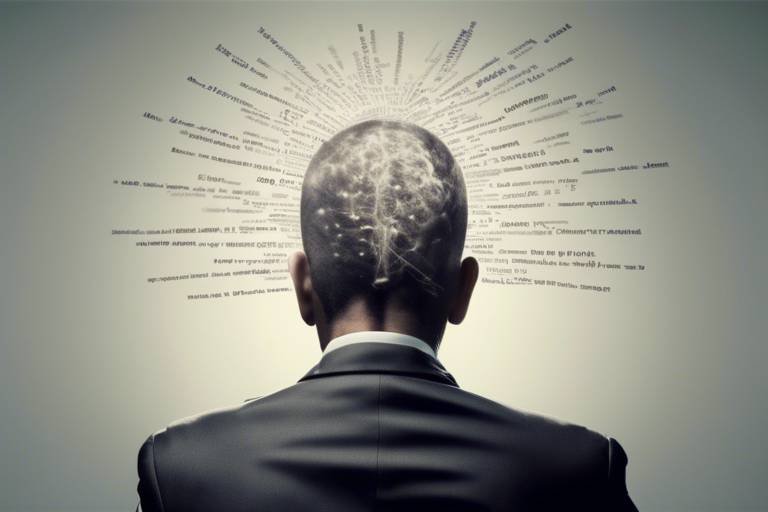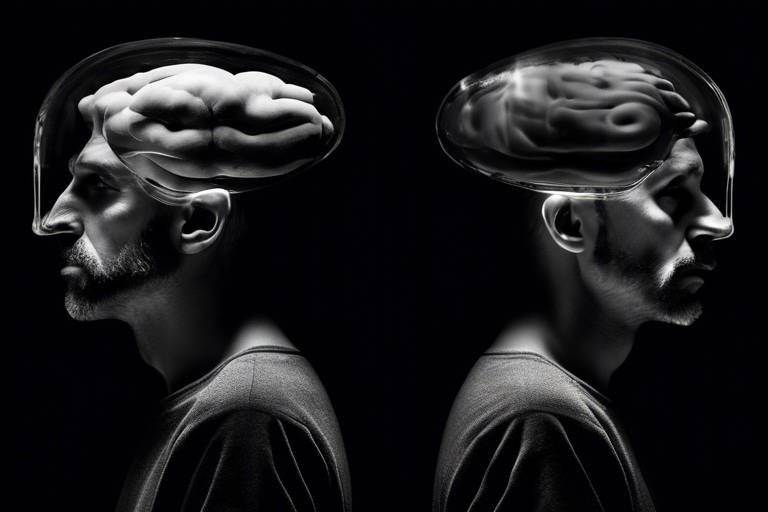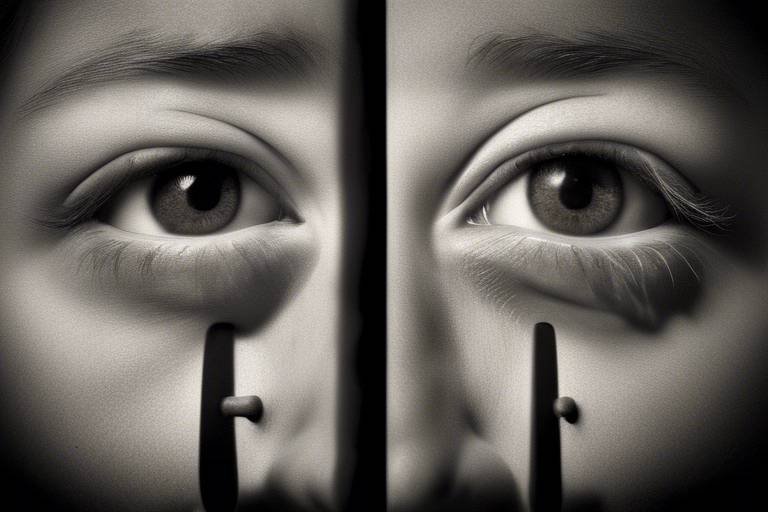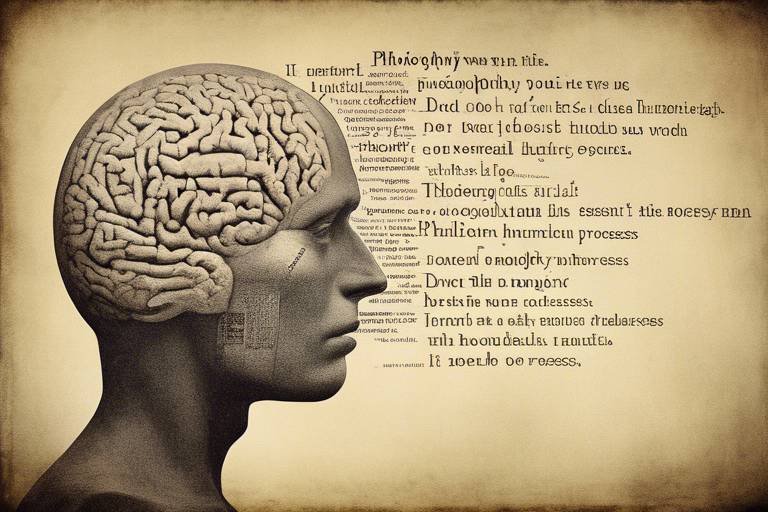The Role of Mind in Defining our Reality
Have you ever stopped to think about how your mind shapes your reality? It’s a fascinating concept, isn’t it? Our thoughts, beliefs, and perceptions create a unique lens through which we view the world. Imagine for a moment that your mind is like a pair of glasses. Depending on how you adjust those lenses, the world can appear vibrant and full of possibilities or dull and limiting. This article dives deep into the interplay between our mental frameworks and the environment, showcasing how profoundly our mindset influences our experiences.
At the heart of this exploration is the understanding that reality is not just a fixed entity; it’s a dynamic tapestry woven from our individual perspectives. Whether we’re navigating personal challenges or pursuing our dreams, our mental state plays a pivotal role in determining how we interpret events and situations. In essence, your reality is as much a product of your mind as it is of the external world. So, how does this work? Let’s break it down.
Perception is like the software that runs our mental hardware. It’s the process through which we interpret sensory information, and it can dramatically alter our understanding of the world. For instance, two people can witness the same event but perceive it in entirely different ways. This discrepancy often arises from the psychological mechanisms that govern perception, such as attention, context, and prior experiences.
When we perceive something, we don’t just passively receive information; we actively construct our understanding based on our beliefs and past experiences. This means that our perception can be influenced by a myriad of factors, from our mood to our cultural background. Have you ever noticed how a sunny day can lift your spirits, making everything seem brighter and more cheerful? Conversely, a gloomy day might cast a shadow over your thoughts, leading you to see the world through a more pessimistic lens. This dynamic interplay between perception and reality is what makes our mental frameworks so powerful.
Now, let’s talk about beliefs. These are the convictions that we hold to be true, often without questioning them. Our beliefs are like the filters through which we view the world, and they significantly influence our actions and reactions. For example, if you believe that you’re capable of achieving your goals, you’re more likely to take risks and pursue opportunities. On the other hand, if you harbor doubts about your abilities, you may shy away from challenges, limiting your potential.
Cognitive biases are fascinating quirks of the mind that can distort our perception of reality. They are systematic patterns of deviation from norm or rationality in judgment. Let’s take a closer look at a couple of these biases:
Have you ever found yourself only seeking out information that supports your existing beliefs? That’s confirmation bias at work! This bias leads individuals to favor information that confirms their preconceptions, effectively creating an echo chamber. Understanding this bias is crucial because it distorts our perception of reality, making us less open to new ideas or perspectives.
The anchoring effect is another cognitive bias that can heavily influence our judgments. It occurs when individuals rely too much on the first piece of information they encounter. For example, if you hear that a car costs $30,000, you might perceive a car priced at $25,000 as a great deal, even if it’s still more than you initially planned to spend. This effect highlights how our initial impressions can skew our decision-making processes.
In a world filled with distractions, practicing mindfulness can be a game-changer. Mindfulness enhances our awareness and can significantly alter our perception of reality. By focusing on the present moment and observing our thoughts without judgment, we can reshape our experiences. Imagine standing on a busy street corner, feeling overwhelmed by the noise and chaos. Now, picture taking a deep breath, grounding yourself, and observing the scene with fresh eyes. Suddenly, the chaos transforms into a vibrant tapestry of life, filled with stories waiting to be discovered.
Our emotions are powerful forces that shape our perception of reality. When we’re in a positive emotional state, we tend to see the world through rose-colored glasses, often interpreting situations optimistically. Conversely, negative emotions can cloud our judgment and distort our understanding of reality. For instance, when we’re angry or fearful, we may perceive threats where none exist, leading to misunderstandings and conflict.
Positive thinking has been shown to foster a more optimistic view of reality. When we cultivate a positive mindset, we open ourselves up to new possibilities and experiences. It’s like flipping a switch that illuminates the path ahead, making challenges seem surmountable and opportunities more accessible.
On the flip side, negative emotions can significantly distort our perception of reality. Feelings of fear, anger, or sadness can create a fog that obscures our judgment, leading us to misinterpret situations or react defensively. It’s essential to recognize these emotional states and their effects on our perception, allowing us to navigate our experiences more effectively.
- How can I change my perception of reality?
Start by practicing mindfulness and challenging your existing beliefs. Being aware of cognitive biases can also help you see things more clearly. - What role do emotions play in shaping reality?
Emotions can significantly influence how we perceive experiences. Positive emotions often lead to a more optimistic view, while negative emotions can distort our understanding. - Can mindfulness really change my perspective?
Yes! Mindfulness helps you become more aware of your thoughts and feelings, allowing you to respond to situations with clarity rather than reacting impulsively.

The Power of Perception
This article explores how our thoughts, beliefs, and perceptions shape our understanding of reality. It delves into the interplay between mind and environment, highlighting the profound influence of mental frameworks on our experiences.
Perception is like the lens through which we view the world; it colors our experiences and influences our understanding of everything around us. Have you ever noticed how two people can witness the same event yet walk away with entirely different interpretations? This phenomenon is a testament to the power of perception. Our minds are not merely passive receivers of information; they actively interpret and filter experiences based on our unique backgrounds, beliefs, and emotions.
At its core, perception involves a series of psychological mechanisms that help us make sense of the world. These mechanisms include attention, interpretation, and memory. For instance, when we focus our attention on specific details, we inadvertently ignore others. This selective focus can lead to very different realities for different individuals. Think of it like a movie: if you're engrossed in the lead character's journey, you might miss the subtle nuances in the background, which could completely change the story's context.
Moreover, our perceptions are shaped by our past experiences. If someone has faced rejection in relationships, they might perceive a friendly gesture as a potential threat. This is where the mind begins to play tricks on us. It’s crucial to recognize that our perceptions can sometimes be distorted, leading us to conclusions that may not reflect the true nature of reality. Understanding this can empower us to challenge our assumptions and broaden our perspectives.
To illustrate this, let’s consider a few examples of how perception can vary:
- Contextual Influence: The same statement can be perceived differently depending on the context in which it is heard. A compliment in a professional setting might be seen as genuine, while the same words in a personal context might be interpreted as insincere.
- Social Influence: Group dynamics can alter our perceptions. When surrounded by a particular belief system, we may adopt those views without questioning them, leading to a collective perception that might not align with reality.
- Emotional State: Our current emotional state can heavily influence how we perceive events. For example, someone feeling happy may interpret a neutral event as positive, while someone in a bad mood might view the same event negatively.
Understanding the power of perception is not just an academic exercise; it has real-world implications. It affects our relationships, our decision-making, and even our mental health. By becoming aware of how our perceptions shape our reality, we can take steps to cultivate a more balanced view of the world. This awareness can lead to greater empathy and understanding, allowing us to navigate our interactions with others more effectively.
In the end, perception is a double-edged sword. While it can enhance our experiences and help us connect with others, it can also lead us astray if we’re not careful. The key lies in maintaining an open mind and questioning our initial interpretations. After all, reality is often a complex tapestry woven from the threads of our perceptions, beliefs, and emotions.
Q: How can I improve my perception of reality?
A: Start by practicing mindfulness and self-reflection. This can help you become aware of your biases and assumptions, allowing you to approach situations with a clearer mindset.
Q: Are perceptions always accurate?
A: No, perceptions can be influenced by various factors, including emotions, past experiences, and social contexts. It's essential to recognize that what we perceive may not always align with reality.
Q: How does perception affect decision-making?
A: Our perceptions can heavily influence our choices. If we perceive a situation negatively, we might avoid it, even if it could be beneficial. Understanding this can help us make more informed decisions.

Beliefs and Their Impact
Beliefs are like the lenses through which we view the world; they shape our realities and influence our behavior in profound ways. From the moment we wake up to the time we go to bed, our beliefs dictate how we interpret events, interact with others, and even how we perceive ourselves. Have you ever noticed how two people can experience the same event yet walk away with entirely different interpretations? This phenomenon is largely due to the beliefs each individual holds. These beliefs are formed through a combination of personal experiences, cultural influences, and social interactions, creating a unique mental framework for each person.
To illustrate this, consider the following example: imagine two individuals facing a job interview. One person believes they are capable and deserving of the position, while the other doubts their abilities and fears rejection. The first individual enters the interview with confidence, ready to showcase their skills, while the second may fumble their words and miss opportunities to shine. This stark contrast highlights how beliefs can directly impact our actions and outcomes.
Our beliefs not only influence our behavior but also affect our emotional states. For instance, someone who believes that challenges are opportunities for growth is likely to approach difficulties with resilience and optimism. In contrast, a person who views challenges as insurmountable obstacles may feel overwhelmed and discouraged. This interplay between beliefs and emotions creates a feedback loop that reinforces our perceptions of reality.
It's essential to recognize that beliefs can be both empowering and limiting. On one hand, positive beliefs can propel us toward success, fostering a sense of agency and motivation. On the other hand, negative beliefs can trap us in cycles of self-doubt and fear. This brings us to the concept of cognitive restructuring, a technique used in cognitive-behavioral therapy to challenge and change unhelpful beliefs. By actively questioning the validity of our beliefs, we can begin to reshape our perceptions and, ultimately, our realities.
To further understand the impact of beliefs, let’s take a look at some common types of beliefs and their potential effects:
| Type of Belief | Potential Effect |
|---|---|
| Empowering Beliefs | Encourage growth, resilience, and a positive outlook on life. |
| Limiting Beliefs | Foster self-doubt, fear of failure, and a sense of helplessness. |
| Core Beliefs | Deeply held convictions that shape our identity and worldview. |
| Social Beliefs | Influenced by cultural norms and societal expectations, affecting our interactions. |
In conclusion, our beliefs play a crucial role in shaping our reality. They influence not only how we perceive the world but also how we engage with it. By becoming aware of our beliefs and actively working to cultivate empowering ones, we can transform our experiences and create a more fulfilling reality. So, what beliefs are you holding onto? Are they serving you or holding you back?
- How do beliefs form? Beliefs are formed through personal experiences, cultural influences, and social interactions.
- Can beliefs be changed? Yes, through techniques like cognitive restructuring, individuals can challenge and change limiting beliefs.
- What is the impact of negative beliefs? Negative beliefs can lead to self-doubt, fear, and a distorted perception of reality.
- How can I cultivate positive beliefs? By practicing self-reflection, surrounding yourself with positive influences, and challenging negative thoughts.

Cognitive Biases
Cognitive biases are like those sneaky little gremlins that distort our thinking, often without us even realizing it. They are systematic patterns of deviation from norm or rationality in judgment, and they can significantly shape our perceptions of reality. Imagine you’re wearing a pair of glasses that only lets you see certain colors; that’s essentially what cognitive biases do to our thinking. They filter our experiences and influence how we interpret information, leading us to draw conclusions that may not be entirely accurate. It’s fascinating—and a bit scary—how our minds can play tricks on us!
One of the most common cognitive biases is the confirmation bias. This is where we tend to seek out, interpret, and remember information that confirms our existing beliefs, while ignoring or dismissing evidence that contradicts them. For instance, if you believe that a particular diet is the best, you might only pay attention to success stories and ignore the failures. This bias can create an echo chamber in our minds, reinforcing our views and limiting our understanding of the broader picture.
Another interesting bias is the anchoring effect. This occurs when we rely too heavily on the first piece of information we encounter. Think of it like a ship anchored in one spot; it can be hard to move away from that initial anchor. For example, if you see a shirt priced at $100 and then find a similar one for $50, you might think the second shirt is a great deal, even if it’s overpriced compared to other options. This reliance on initial information can skew our judgment and decision-making processes.
| Cognitive Bias | Description |
|---|---|
| Confirmation Bias | Tendency to search for, interpret, and remember information that confirms existing beliefs. |
| Anchoring Effect | Relying too heavily on the first piece of information encountered, affecting subsequent judgments. |
Understanding these cognitive biases is crucial for anyone looking to gain a clearer perspective on their reality. By recognizing how these biases operate, we can start to question our thought processes and challenge our assumptions. It’s like turning on a light in a dark room; suddenly, everything becomes clearer, and we can see the full picture rather than just isolated fragments. This awareness can help us make more informed decisions, improve our relationships, and enhance our overall well-being.
In conclusion, cognitive biases are powerful forces that shape our perceptions and experiences. By becoming aware of them, we can take steps to mitigate their effects and strive for a more balanced understanding of the world around us. So, the next time you find yourself jumping to conclusions or clinging to a belief, take a moment to pause and reflect: could a cognitive bias be at play?
- What are cognitive biases? Cognitive biases are systematic patterns of deviation from norm or rationality in judgment, affecting how we perceive information.
- How do cognitive biases impact decision-making? They can distort our judgment by leading us to favor information that aligns with our beliefs, potentially resulting in poor choices.
- Can we overcome cognitive biases? While we may not eliminate them entirely, awareness and mindfulness can help us recognize and mitigate their effects.

Have you ever found yourself scrolling through social media, only to notice that the content you see aligns perfectly with your beliefs? This phenomenon is known as confirmation bias, and it plays a significant role in shaping our perception of reality. Essentially, confirmation bias is the tendency to search for, interpret, and remember information in a way that confirms our pre-existing beliefs while disregarding or minimizing information that contradicts them. It's like wearing a pair of tinted glasses that only allow certain colors to shine through, leaving everything else in the shadows.
Imagine you’re a fan of a particular sports team. You might only notice articles and posts that highlight their victories and downplay their losses. This selective exposure not only reinforces your loyalty but also skews your understanding of the team's actual performance. In a broader sense, confirmation bias can lead to a distorted view of reality, influencing everything from political opinions to personal relationships.
Understanding confirmation bias is crucial because it can affect our decision-making processes profoundly. When we favor information that aligns with our beliefs, we may make choices based on an incomplete understanding of the situation. For instance, in a workplace setting, a manager who believes that their team is underperforming may only focus on negative feedback while ignoring positive outcomes. This can lead to misguided strategies and a toxic work environment.
To illustrate the impact of confirmation bias, consider the following table that outlines its effects on different aspects of life:
| Aspect of Life | Effect of Confirmation Bias |
|---|---|
| Politics | Polarization of opinions, leading to echo chambers |
| Health | Ignoring medical advice that contradicts personal beliefs |
| Relationships | Focusing on negative traits while overlooking positive ones |
| Work | Misjudgment of team performance and capabilities |
Breaking free from the grip of confirmation bias requires a conscious effort. It’s essential to challenge our own beliefs and actively seek out diverse perspectives. Engage with sources that present opposing viewpoints and encourage open discussions with people who think differently. By doing so, we not only expand our understanding but also cultivate a more balanced and nuanced view of reality.
In conclusion, while confirmation bias is a natural cognitive shortcut that helps us make sense of the world, it can also lead to significant distortions in our perception. Being aware of this bias and striving for a more holistic understanding can ultimately enhance our decision-making and enrich our experiences. So, the next time you find yourself only acknowledging information that aligns with your views, take a step back and ask yourself: what might I be missing?
- What is confirmation bias? Confirmation bias is the tendency to favor information that confirms one’s existing beliefs while ignoring contradictory evidence.
- How does confirmation bias affect decision-making? It can lead to poor decision-making by creating a skewed perception of reality, as individuals may only consider information that supports their views.
- Can confirmation bias be overcome? Yes, by actively seeking out diverse perspectives and challenging one’s own beliefs, individuals can reduce the effects of confirmation bias.

The anchoring effect is a fascinating psychological phenomenon that illustrates how our minds can latch onto the first piece of information we encounter, which then serves as a reference point for all subsequent judgments and decisions. Imagine walking into a car dealership and seeing a flashy sports car priced at $100,000. Even if you had a budget of $30,000, that initial price tag could skew your perception of what a reasonable price is for any vehicle you consider afterward. This is the anchoring effect at work, subtly influencing your expectations and decisions without you even realizing it.
This cognitive bias is not just limited to pricing; it permeates various aspects of our lives, from shopping to negotiations and even personal relationships. For example, when negotiating a salary, the first number mentioned can significantly impact the final outcome. If the employer starts with a high figure, it can anchor the conversation, making lower offers seem less appealing. Conversely, if the initial offer is low, it may set a negative tone for the negotiation process.
Research has shown that the anchoring effect can lead to substantial discrepancies in decision-making. In one study, participants were asked to estimate the percentage of African nations in the United Nations. Before making their estimates, they were shown a random number, which served as an anchor. Those shown a higher number tended to estimate a higher percentage, demonstrating how powerful the anchor can be. The human mind, it seems, is not as rational as we like to think; we often rely on these anchors, even when they are irrelevant.
So, how can we mitigate the influence of the anchoring effect in our lives? Here are a few strategies:
- Awareness: Simply being aware of the anchoring effect can help you recognize when it’s influencing your decisions.
- Seek Multiple Perspectives: Gathering various viewpoints can provide a broader context, helping to dilute the impact of any single anchor.
- Delay Decision-Making: Taking time to reflect on your choices can allow you to reassess any anchors that may be skewing your judgment.
In conclusion, the anchoring effect is a powerful reminder of how our minds work, often leading us to make decisions based on arbitrary references rather than objective reasoning. By understanding this bias, we can become more mindful consumers and negotiators, ultimately leading to better decision-making in our daily lives.

Mindfulness and Awareness
In our fast-paced world, where distractions lurk around every corner, mindfulness has emerged as a beacon of hope for many seeking clarity and peace. But what exactly is mindfulness? At its core, mindfulness is the practice of being fully present in the moment, observing our thoughts and feelings without judgment. Imagine standing on a busy street corner, cars zooming by, people rushing past, and yet, in that chaos, you find a moment of stillness. This is the essence of mindfulness—finding tranquility amidst the storm.
Research shows that practicing mindfulness can significantly alter our perception of reality. By enhancing our awareness, we can better understand how our thoughts shape our experiences. When we engage in mindfulness practices, such as meditation or deep-breathing exercises, we train our brains to focus on the present. This shift in focus can lead to a more profound understanding of our emotions and thoughts, allowing us to respond to situations rather than react impulsively.
One of the most exciting aspects of mindfulness is its ability to reshape our mental frameworks. When we cultivate awareness, we begin to notice patterns in our thinking. For example, we might realize that we often dwell on negative experiences or catastrophize situations that aren't as dire as they seem. By recognizing these patterns, we can consciously shift our mindset. Here are some key benefits of mindfulness:
- Enhanced Emotional Regulation: Mindfulness helps us to recognize and manage our emotions more effectively, reducing stress and anxiety.
- Improved Focus: Regular mindfulness practice can lead to better concentration and attention, making it easier to navigate daily tasks.
- Greater Self-Awareness: By observing our thoughts and feelings, we develop a deeper understanding of ourselves, which can lead to personal growth.
Moreover, mindfulness has been shown to have a tangible impact on our physical health. Studies indicate that individuals who practice mindfulness regularly experience lower blood pressure, improved immune function, and even better sleep quality. It’s as if mindfulness acts as a reset button for our minds and bodies, allowing us to recover from the wear and tear of modern life.
Incorporating mindfulness into your daily routine doesn’t have to be daunting. Simple practices, such as taking a few minutes each day to focus on your breath or engaging in mindful walking, can make a significant difference. The key is consistency. Just like building a muscle, the more you practice mindfulness, the stronger your ability to remain present will become.
So, how can we cultivate mindfulness in our lives? Here are a few strategies:
- Start Small: Dedicate just five minutes a day to mindfulness meditation.
- Be Curious: Approach your thoughts with curiosity rather than judgment.
- Practice Gratitude: Acknowledge the positive aspects of your life, no matter how small.
In conclusion, mindfulness is not just a trend; it’s a powerful tool that can dramatically alter our perception of reality. By fostering awareness and presence, we can navigate our lives with greater clarity and purpose. So, the next time you find yourself overwhelmed, take a moment to breathe, observe, and simply be. You might be surprised at how much your reality can shift.
Q: What is mindfulness?
A: Mindfulness is the practice of being fully present and engaged in the moment, observing thoughts and feelings without judgment.
Q: How can I practice mindfulness?
A: You can practice mindfulness through meditation, deep-breathing exercises, or simply by focusing on the present moment during daily activities.
Q: What are the benefits of mindfulness?
A: Benefits include enhanced emotional regulation, improved focus, greater self-awareness, and positive effects on physical health.

Emotional Influence on Reality
Emotions are like the lenses through which we view the world. They shape our perceptions, influence our decisions, and ultimately define our reality. Have you ever noticed how a simple change in mood can flip your day upside down? One moment you’re on top of the world, and the next, a cloud of negativity looms over you, distorting everything in sight. This phenomenon is not just anecdotal; it’s grounded in psychology. Our emotional states can color our experiences, leading us to interpret the same situation in vastly different ways.
For instance, when you’re feeling happy, you might perceive a crowded room as vibrant and full of potential connections. However, on a bad day, that same room could feel overwhelming and isolating. This emotional influence is not just about perception; it can trigger a cascade of biological responses that affect how we interact with our environment. Our brains release various chemicals based on our emotional states, which can either enhance or inhibit our cognitive functions. In essence, our feelings can either open our minds to new possibilities or close them off entirely.
Moreover, the connection between emotions and reality is not merely personal; it has social implications as well. When we are emotionally charged, we often project our feelings onto others, interpreting their actions through the lens of our current mood. For example, if you’re feeling anxious, you might perceive someone’s neutral expression as disinterest or judgment. This can lead to misunderstandings and conflicts that might not have occurred had you been in a different emotional state. It’s like wearing a pair of tinted glasses that alter your view of the world, making it essential to check in with our emotions regularly.
In a broader context, the collective emotional state of a community or society can shape its reality. Consider how fear or optimism can influence public opinion, policy decisions, and even economic conditions. During times of uncertainty, fear can spread like wildfire, leading to panic and irrational behavior. Conversely, a wave of optimism can inspire innovation and resilience. This interconnectedness highlights the importance of emotional awareness not just for individual well-being but for societal health as well.
To truly understand the emotional influence on reality, we must also consider the role of emotional intelligence. Individuals with high emotional intelligence can navigate their feelings and those of others more effectively. They are better equipped to manage stress, communicate clearly, and empathize with different perspectives. This skill set not only enhances personal relationships but also fosters a more harmonious social environment. By cultivating emotional intelligence, we can learn to recognize how our emotions shape our reality and, in turn, choose how we respond to them.
In conclusion, the emotional influence on reality is profound and multifaceted. Our feelings dictate not only our personal experiences but also how we relate to the world around us. By acknowledging and understanding this influence, we can take proactive steps to manage our emotional states, leading to a clearer, more balanced perception of reality. Remember, the next time you find yourself in a funk, it might just be your emotions playing tricks on you. Take a step back, breathe, and reassess your view—you might be surprised at what you discover!
- How do emotions affect decision-making?
Emotions can significantly influence our choices, often leading us to make decisions based on feelings rather than logic. For example, fear might prevent us from taking risks, while happiness might encourage us to pursue new opportunities.
- Can mindfulness help in managing emotions?
Absolutely! Mindfulness practices can enhance our awareness of emotions, allowing us to respond rather than react. This can lead to healthier emotional regulation and a clearer perspective on reality.
- What role does emotional intelligence play in social interactions?
Emotional intelligence helps individuals understand and manage their own emotions while empathizing with others. This skill is crucial for effective communication and building strong relationships.

The Role of Positive Thinking
Positive thinking is more than just a feel-good mantra; it’s a powerful tool that can reshape our perception of reality. Imagine walking into a room filled with people. If you enter with a positive mindset, you're likely to notice the friendly faces and engaging conversations. However, if you're feeling negative, all you might see are the frowns and disinterest. This simple example illustrates how our thoughts can significantly influence our experiences.
Research shows that maintaining a positive outlook can lead to numerous benefits, not just for our emotional health but also for our physical well-being. People who practice positive thinking often report lower levels of stress and anxiety, which can enhance their overall quality of life. They tend to approach challenges with a more optimistic perspective, viewing obstacles as opportunities for growth rather than insurmountable barriers. This shift in mindset can lead to better problem-solving skills and increased resilience in the face of adversity.
But how does one cultivate this positive thinking? It often starts with awareness. By becoming mindful of our thoughts, we can challenge negative patterns and replace them with more constructive ones. For instance, instead of saying, "I can’t do this," try rephrasing it to, "I will do my best." This simple change can create a ripple effect, transforming not just our thoughts but our actions as well.
Incorporating positive affirmations into daily routines can also be beneficial. Affirmations are short, powerful statements that can help reinforce a positive self-image and mindset. Here are a few examples:
- I am capable of achieving my goals.
- I choose to focus on the good in my life.
- I am resilient and can overcome challenges.
Moreover, surrounding ourselves with positive influences—be it supportive friends, uplifting books, or motivational podcasts—can significantly enhance our ability to think positively. Like a garden, our minds thrive when nourished with positivity. On the flip side, negative influences can act like weeds, choking out the healthy growth we strive for.
It's also essential to acknowledge that positive thinking doesn’t mean ignoring reality or pretending everything is perfect. Life is full of ups and downs, and it’s okay to feel sad or frustrated. The key is to approach these feelings with a mindset that seeks solutions rather than wallowing in despair. By doing so, we can maintain a balanced perspective that allows us to navigate life’s challenges more effectively.
In conclusion, the role of positive thinking in shaping our reality cannot be overstated. It empowers us to see possibilities instead of limitations, to embrace challenges rather than fear them, and to cultivate a life filled with joy and purpose. So, why not give it a try? Start today by consciously shifting your thoughts towards the positive and watch how it transforms your perception of reality.
Q: Can positive thinking really change my life?
A: Yes! Positive thinking can lead to improved mental and physical health, better relationships, and increased resilience in facing challenges.
Q: How can I start practicing positive thinking?
A: You can start by becoming aware of your thoughts, using positive affirmations, and surrounding yourself with uplifting influences.
Q: Is it normal to have negative thoughts?
A: Absolutely! Everyone experiences negative thoughts. The key is to acknowledge them and consciously shift your focus to the positive.

Negative Emotions and Distortion
Negative emotions can act like a thick fog, clouding our judgment and distorting our perception of reality. When we experience emotions such as fear, anger, or sadness, our ability to see situations clearly becomes compromised. Imagine trying to drive through a dense fog; everything appears distorted and unclear, making it difficult to navigate. This analogy perfectly illustrates how our emotional states can alter our understanding of the world around us.
For instance, when we are engulfed in fear, our mind tends to focus on potential threats, often exaggerating their significance. This heightened state of alert can lead to irrational decision-making. It’s as if our brain is wearing a pair of distorted glasses, magnifying risks while minimizing opportunities. Similarly, when anger takes hold, it can warp our perception, causing us to view others’ actions through a lens of hostility. We may interpret neutral behaviors as aggressive, leading to unnecessary conflicts and misunderstandings.
Moreover, sadness can create a sense of hopelessness, making it challenging to see the silver lining in any situation. When we are sad, our brain tends to dwell on negative experiences, reinforcing a cycle of pessimism. This emotional distortion can lead to a skewed view of reality, where we may feel trapped in a never-ending loop of despair and negativity.
To better understand how these negative emotions distort our perception, consider the following table that outlines the common emotional states and their potential impacts on our reality:
| Emotional State | Impact on Perception |
|---|---|
| Fear | Exaggerates threats, leading to irrational decisions. |
| Anger | Warps interpretation of others’ intentions, fostering conflict. |
| Sadness | Creates a sense of hopelessness, focusing on negative experiences. |
Recognizing the influence of these negative emotions is the first step toward regaining control over our perceptions. By practicing emotional awareness, we can learn to identify when we are being influenced by distorted feelings. Techniques such as deep breathing, journaling, or talking to a trusted friend can help us process these emotions more effectively, allowing us to see situations with greater clarity.
In conclusion, negative emotions can significantly distort our perception of reality, leading us to make decisions based on skewed interpretations. However, by acknowledging these emotions and employing strategies to manage them, we can begin to navigate through the fog and regain a clearer view of the world around us.
- How can I manage negative emotions effectively? - Techniques such as mindfulness, talking to someone, and engaging in physical activity can help.
- What are some signs that my emotions are distorting my perception? - If you find yourself consistently misinterpreting others' actions or feeling overwhelmed by negative thoughts, it may be a sign.
- Can positive thinking counteract negative emotions? - Yes, cultivating a positive mindset can help shift your focus and alter your perception of reality.
Frequently Asked Questions
- How do our thoughts influence our reality?
Our thoughts act like a lens through which we view the world. They shape our perceptions and ultimately define our experiences. If we think positively, we tend to notice the good around us, while negative thoughts can cloud our judgment and lead to a distorted view of reality.
- What is the role of beliefs in shaping our actions?
Beliefs serve as the foundation for our actions and reactions. They guide our decisions and influence how we interpret experiences. When we hold strong beliefs, we often act in ways that reinforce them, which can create a cycle that further entrenches those beliefs.
- Can cognitive biases affect our perception of reality?
Absolutely! Cognitive biases, like confirmation bias and the anchoring effect, can skew our understanding of reality. For example, confirmation bias leads us to seek out information that supports our existing beliefs, while the anchoring effect can cause us to rely too heavily on initial information, regardless of its accuracy.
- What is mindfulness, and how can it change our perception?
Mindfulness is the practice of being present and fully engaged with the moment. By cultivating mindfulness, we can enhance our awareness and gain a clearer perspective on our thoughts and feelings. This practice can help us reshape our experiences and alter how we perceive reality.
- How do emotions impact our understanding of reality?
Emotions are powerful influencers of our perceptions. Positive emotions can lead to a more optimistic view of our surroundings, while negative emotions like fear or anger can distort our judgment. Being aware of our emotional state can help us navigate our experiences more effectively.
- Is positive thinking really beneficial?
Yes! Positive thinking can foster a more optimistic outlook on life, leading to better mental health and improved coping strategies. By focusing on the positive aspects of situations, we can enhance our overall experience and create a more fulfilling reality.
- What are some strategies to combat negative emotions?
To combat negative emotions, consider practices such as mindfulness, journaling, or talking to someone you trust. These strategies can help you process your feelings and gain a clearer understanding of your experiences, ultimately reducing the impact of those negative emotions on your perception of reality.



















